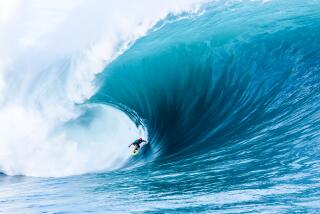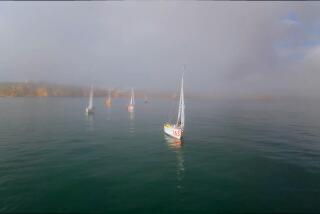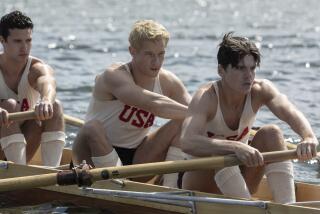Cup Entries Rehearse for Show : Sailing: Winning is not everything right now. The goal is to be ready for 1992.
- Share via
SAN DIEGO — In what sporting event do the competitors show up a year in advance?
Only in the America’s Cup.
When do some of the world’s richest men neglect their businesses and sometimes go to court to fight for 132 ounces of silver?
Only in the America’s Cup.
When do competitors switch their national allegiances?
Only in the America’s Cup.
The series of sailboat races starting at 12:30 p.m. today is billed as the first International America’s Cup Class World Championship. In reality it is a dress rehearsal for the spectacle this city hopes to achieve starting in January and a tryout for the boats and crews.
There will be nine boats from six countries, with one star: the man who has won, lost and won the last three multinational Cups since 1980, plus a bizarre defense with a catamaran against a mini-aircraft carrier from New Zealand in ’88.
Heeeeere’s Dennis!
Conner finished a creditable third in two practice races Wednesday, then remained in port for the last one Thursday when forecasts called for winds too strong for a team that owns only one boat, one mast and one mainsail.
See, winning the worlds isn’t the point here.
The point for Conner, he says, is “to try to learn as much as we can about the other boats and to give up as little (information) about our boat as we can.”
The fleet also includes the Nippon Challenge, with skipper Chris Dickson from New Zealand; two boats from Italy’s Il Moro di Venezia, with American skippers Paul Cayard and John Kolius, and New Zealand, with American Rod Davis serving as an alternate skipper in rotation with David Barnes and Russell Coutts.
Confused? Can you imagine Conner sailing for, say, France?
No, that’s Marc Pajot on Ville de Paris. Then there are Pedro Campos and Antonio Gorostegui sailing for Spain on a boat borrowed from New Zealand, and two boats entered by Bill Koch, who heads the only other defense syndicate besides Conner’s.
Koch will steer the newest one himself--the one built secretly at Hercules Aerospace in Utah--while Buddy Melges will be at the helm of the other, whose days are numbered until Koch’s second boat arrives in July.
They’ll sail one fleet race each of the next five days around the new Cup course, which is a 21.2-mile maze of eight legs upwind, downwind and reaching (across the wind). No racing is scheduled Thursday, followed by match-racing sail-offs among the top four survivors Friday and Saturday.
Nippon performed best in the three practice races, followed closely by Il Moro and New Zealand, and there is no reason to believe that will change in the worlds. The syndicates Conner calls “the big three” have had the best-funded and longest-running programs and would be in in serious trouble if they weren’t in front at this point.
“Until someone comes out faster than the big three, they’re the favorites,” Conner said.
Conner’s participation in the worlds is still day to day.
“We’re going to be on the starting line (every day), but we’re going to use our heads,” he said. “We won’t let our competitive instincts overrule our common sense.”
Translation: if the weather looks like a gearbuster, Stars & Stripes will sail back home.
Skippers for America-3 and New Zealand said they’d like to do away with the Z-leg in the worlds and just sail standard windward-leeward courses.
Gary Jobson of A-3 said, “My problem with the leg is that every match-race regatta in the world is a windward-leeward (event), and on the windward-leeward legs you have a greater chance of passing. I think it’s gonna be a parade on those (reaching) legs.”
So Tom Ehman, executive director of the America’s Cup Organizing Committee, proposed that two days of the worlds be changed to two windward-leeward races instead. The proposal died when the skippers met to discuss it Friday.
Il Moro’s John Kolius said it would have been a shame to change it because, “I just now learned all the Italian expressions for the original course.”
New Zealand’s David Barnes said, “I think maybe it should be a starboard rounding (at the downwind mark). It’s potentially very dangerous in a fleet situation coming through there.
“Perhaps with the match racing, with only two boats on the course, you could probably get away with it.”
The tricky part is making a 180-degree turn while changing sails and heading back into the fleet still approaching the mark.
John Bertrand of Conner’s team said, “We had our bow (crew) out there (Thursday) specifically to see that maneuver because, frankly, we’ve never practiced it. We’ll be flying a little blind Saturday.”
But a change now would penalize the advanced teams that have been drilling on the maneuver, have amassed inventories of sails, such as gennakers, for reaching, and perhaps have designed technology for the Z-leg into their boats.
Dickson said, “The zig-zag leg is something that’s been on the course chart for more than a year, and my crew would be very disappointed if the work they’d put in training for it was suddenly taken out of the picture again.
“Historically, the crew doesn’t get pushed all that often. In most races they do two or three spinnaker sets, two spinnaker drops, four or five jibes. For a bit of excitement and a lot of action, it’s good to push not only the designers and the tacticians and the skippers but to push the crews and give them a chance to show that they contribute to the winning or losing.”
Will the crews really be trying in the worlds, at the risk of showing how fast they really are?
Kolius said, “I think that everybody is going to be going as much as they can. I know most these guys pretty well and when they get on a race course there’s a certain amount of pride. I don’t know if they’re gonna be able to overcome that.”
How tight is the Stars & Stripes budget?
When IACC measurer Ken McAlpine dropped by to check Conner’s allowed inventory of 17 sails the other day, they had trouble coming up with that many.
Spinnakers and jibs (headsails) cost from $15,000 to $20,000 apiece, and Conner has eight of each. He has only one mainsail, because mainsails cost from $40,000 to $50,000.
If sails blow out, they can often be repaired, but mains usually just wear out, like an old pair of pants.
When Conner blew a spinnaker Wednesday, the spare he put up with the Cadillac logo was borrowed from Jim Kilroy’s maxi Kialoa.
Tom Whidden, Conner’s tactician, is president of North Sails. He said that while the mains and spinnakers are larger even than those on maxi-boats, which are about 10 feet longer, the jibs on the IACC boats are virtually identical to the No. 2-size jibs on a maxi, so sometimes they sail with one of those.
Stars & Stripes mainsheet trimmer Vince Brun said he has been impressed with how the crew makes do with innovative repairs and maintenance.
But one thing the team doesn’t have to scrimp on is soda pop. Thanks to one of its major sponsors, there is a machine in the compound with a full selection and endless supply. No coins required--just push a button.
Dickson offered this much about the mysterious forward fin on his Nippon boat.
“(With) these new America’s Cup Class boats, what’s under the water is not measured in any way,” he said. “Each boat is allowed two surfaces that move in a perpendicular plane. Some boats have a rudder and trim tab. Some boats have two rudders.
“With our two-boat program, we will continue to test a number of different options.”
Bruce Nelson, a member of Conner’s design team, said he’s sure it’s a forward rudder, has known about it for some time, is interested in how it works--and noted that some days it’s there and some days it isn’t, suggesting that it is removable.
In fact, any team with a video camera that can afford to rent a helicopter already knows what everybody else has under the waterline, including keel sizes and shapes.
From above, the water is clear enough to show all.
More to Read
Sign up for The Wild
We’ll help you find the best places to hike, bike and run, as well as the perfect silent spots for meditation and yoga.
You may occasionally receive promotional content from the Los Angeles Times.






